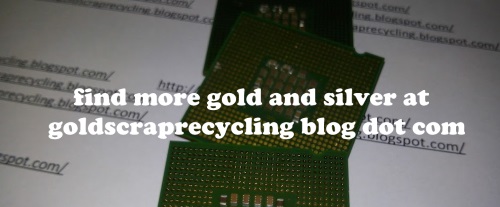The metals contained in PC's commonly include
aluminum, antimony, arsenic, barium, beryllium, cadmium, chromium, cobalt,
copper, gallium, gold, iron, lead, manganese, mercury, palladium, platinum,
selenium, silver, and zinc.
Eight of these metals (shown in bolded type) are listed as hazardous by the
Resource Conservation and Recovery Act (RCRA), one of the Federal laws that
control the disposition of waste in the United States. This law prohibits companies from incinerating some types of electronic
scrap or disposing of it into municipal landfills.
Historically,
recovering precious metals from electronic scrap has been one of the greatest
economic incentives for the electronics recycling industry. However, in an
effort to cut costs, manufacturers have gradually reduced the precious metal
content in electronic products, and this trend is likely to continue (Porter,
1998). Information on the specific amounts of individual precious metals (gold, silver, and the platinum group
metals) recovered is unavailable, but as much as one-third of the precious
metals recovered from scrap may be gold (Sean Magaan, Noranda, Inc., Micro
Metallics Corp., oral commun., 1999). The value of the 1 t of precious metals
recovered from electronic scrap in the United States in 1998 (table 1) probably
exceeded $3.6 million. This value was obtained by assuming that the precious metals
recovered consisted of 60% silver and 40%
gold, palladium, and platinum. The average price used to calculate the value was $5.10 per troy ounce of silver
and an average of $300 per troy ounce of gold, palladium, and platinum.
Several U.S. companies reported producing more than 1,500 troy ounces per year
of precious metals from electronic scrap (Dawn Amore, National Recycling
Coalition, oral commun., 1999).
Circuit boards and batteriescontain most of the heavy metals, and circuit boards contain the highestprecious metal values. One metric ton of circuit boards can contain
between 80 and 1,500 g of gold and between 160 and 210 kg of copper (Veldhuizen
and Sippel, 1994). This is 40 to 800 times the concentration of gold
contained in gold ore mined in the United States and 30 to 40 times the concentration
of copper contained in copper ore mined in the United States. Gold in an
obsolete computer has little or no value. Like ore, it must be collected,
concentrated, and refined in order to acquire a high value. The United States and foreign mineral processing companies use
electronic scrap from computer circuit boards for two reasons:
(1) it has a high precious metal content
and
(2) it contains much lower levels of deleterious
elements common to ores, such as arsenic, mercury, and,
especially, sulfur.
These elements can
contribute potentially harmful atmospheric emissions (Rob Bouma, Noranda, Inc.,
oral commun., 2000) and could result in additional costs for recovery and disposal.
Military electronic scrap, mostly computer circuit boards, received from the former
Soviet Union (Nadeau, 1999) are especially sought for recycling because of their
comparatively high precious metal content. The scrap can contain 10 times the amount
of precious metals than mined ores and significantly higher amounts of precious
metals as electronic components produced elsewhere.
In the mid-1980's, one
of the world's largest mining companies, Noranda, Inc. (Noranda) of Canada,
investigated ways to make their smelters more profitable. Feasibility studies and testing determined that "mining"
computer and other electronic scrap would bring a welcome supplement of copper
and precious metals to their smelters. Noranda' s findings indicated that
the concentration of some metals in average computer and other electronic scrap
may be more than twice that found in ores.
So in 1984, Noranda began
processing small amounts of scrap (Reid, 1999) and, by 1999, was the largest
electronics recycling plant in North America, receiving more than 50,000 t/yr
of electronic scrap from 300 to 400 suppliers in 18 countries (Nadeau, 1999;
Reid, 1999). Recyclable materials are considered to be an important feed for
Noranda' s smelters, as essential as ore concentrates are to the operation' s
profitability Rob Bouma, Noranda, Inc., written and oral
commun., 1999). In order to treat electronic scrap more efficiently, a
subsidiary of Noranda in California entered into an agreement with the
Hewlett-Packard Company. Hewlett-Packard provides approximately 1,400 t of
obsolete PC’s and other computer-related electronic scrap to Noranda for
recycling on a monthly basis (Reid, 1999). After the computers are dismantled
and the components are separated and tested, the useable components are sold,
and the shredded metals are separated to be sold as scrap or transported to
Noranda’s smelters in Canada. Hewlett-Packard pays Noranda for this service
and, in return, is assured that components with toxic materials are treated
legally, thus avoiding potential liability (Reid, 1999). Hewlett-Packard reuses
or recycles nearly 1,600 t or 99 percent by weight of materials received from
its customers and company operations.
Major electronic
companies also recycle. IBM operates ten materials recovery plants around the
world. In 1997, these operations processed more than 62,000 t of manufacturing
scrap equipment, obsolete IBM machines, and customer-returned equipment. More
than 90 percent was recycled and less than 5 percent was sent to landfills
(Amore, 1999).



